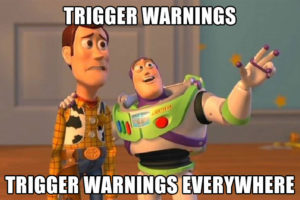Trigger-happy

(Picture: not mine. Thanks, interwebs.)
AKA: Trigger warnings
I started noticing trigger warnings on the internet a while ago (probably two or three years now). They’re usually pretty obvious, screaming from the top of posts or articles about depictions or discussions of rape or paedophilia or specific types of violence.
Since then, they have taken root in the subconscious of the interwebs and spawned in random, haphazard ways. They’re more numerous now, popping up at the top of vague posts that touch any potentially ‘touchy’ subject. Gay relationships. Transsexual issues. Harm to animals. Radical new diets. Swearing. If someone might be offended or made uncomfortable by a subject, people are slapping a trigger warning on it.
This usage annoys me. That’s not what they were intended for. It’s the nanny-state intruding on the interweb, treating us like we’re all delicate snowflakes who can’t behave like conscious, thinking, breathing adults. I find it insulting, unnecessary, and counter-productive.
In my opinion, the meaning of a trigger warning is being watered down and made meaningless. They’re actually becoming less useful and less protective for those who might need them. I think in most cases that the over-use is well-intentioned, but please, let’s think about why we’re warning people about upcoming content.
What trigger warnings are for
This is, I suspect, the root of the problem: a lot of people (yes, I’m generalising here) don’t know why or how to use these warnings. The warnings are being used because they’re trendy, they look informed and supportive and like the thing we should be doing, but little understanding is being given towards the actual reason for them. I’m all about encouraging and enabling understanding, so this is a good place to start.
So what is a trigger warning for? How is it different to a content statement or rating? Why should we use it?
The original intent behind trigger warnings was to go above and beyond the standard content statement or rating: it was to warn survivors of trauma that the content might trigger an anxiety or panic attack.
This is (was?) primarily aimed at those who suffer PTSD, who may suffer flashbacks or anxiety/panic attacks when triggered by sensory stimuli, including visual or worded imagery. When discussing trigger warnings, I most often see survivors of rape or assault mentioned, but I think the list is broader than that: it includes war veterans and those who have witnessed or been part of something mentally scarring (including abusive relationships and situations; the list of possibilities is too long to mention here but hopefully you get the idea: trauma).
The incidents or attacks that these warnings are intended to prevent can be physical as well as psychological. They are debilitating and upsetting, and can cause real harm. Helping survivors to avoid these attacks is key to their healing process, as warnings give them a way to manage their own feelings of safety.
This is not to say that trigger warnings are flags for ‘stuff PTSD sufferers shouldn’t expose themselves to’. This is a flag that says ‘some might find this content triggers their trauma’, and gives the person the opportunity to prepare themselves for it. It’s about preparation, not avoidance. (In fact, avoidance can worsen PTSD.)
I read an article recently (I can’t find the link, sadly 



